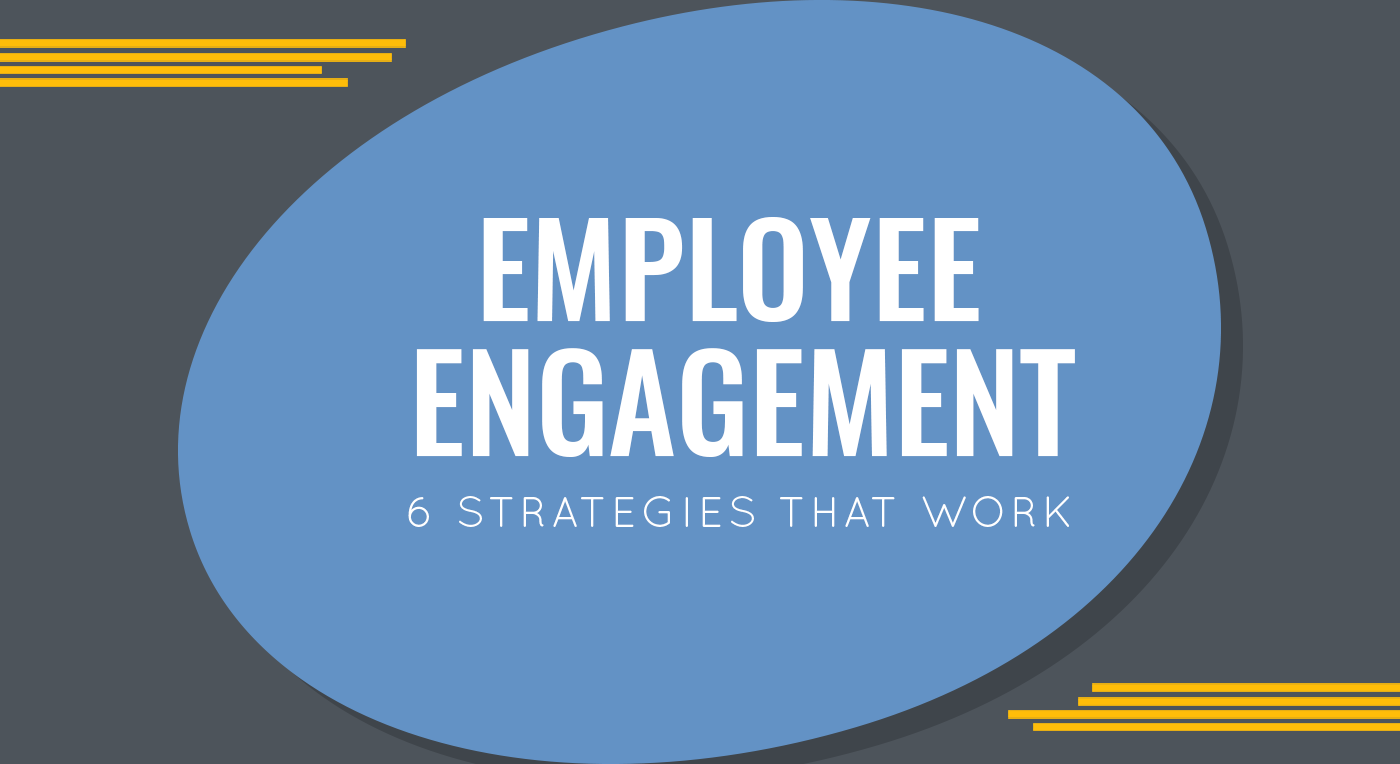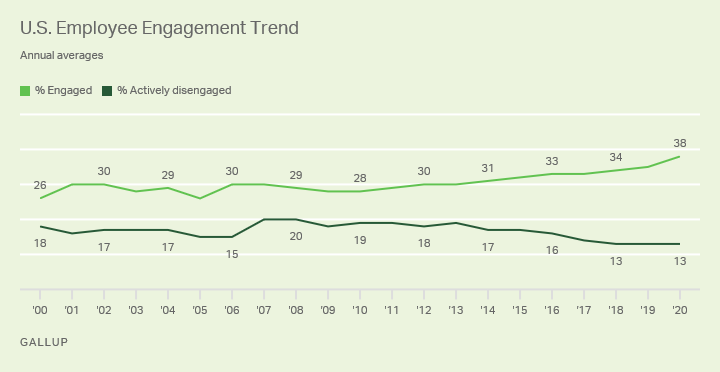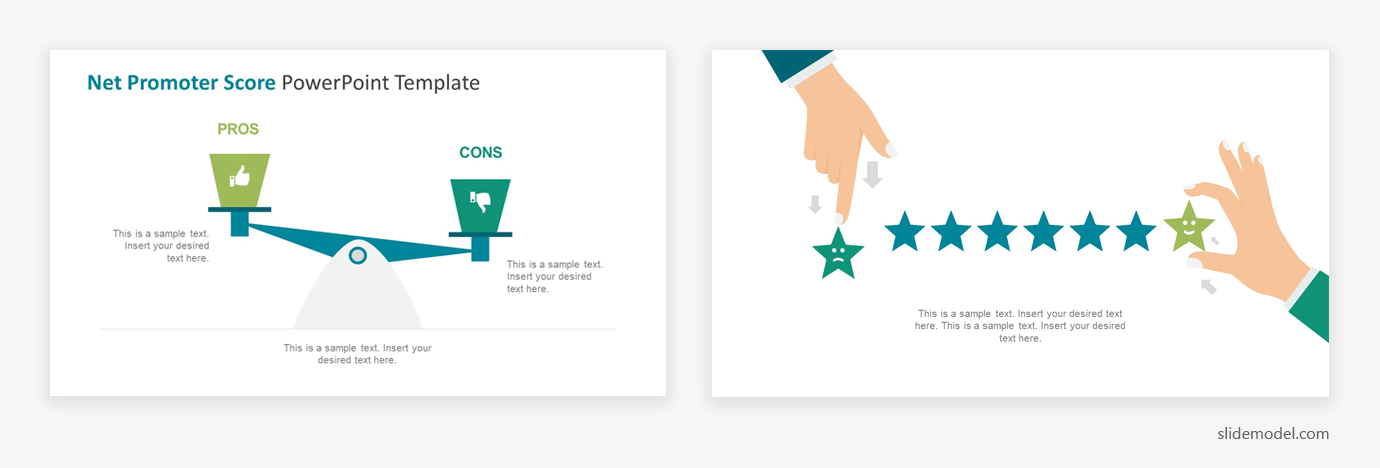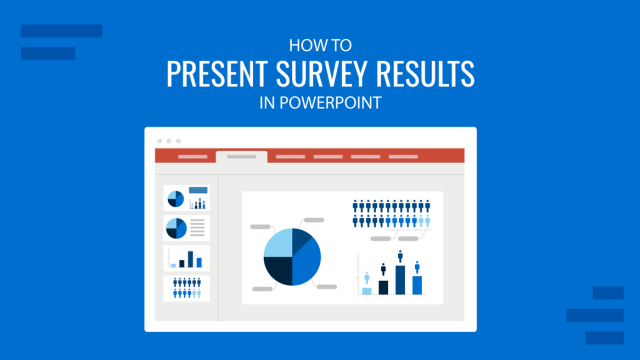
Happy and productive employees are good for business—it’s a fact. However, few workplaces manage to maintain high engagement levels. In 2020, 49% of workers stated that they were disengaged, according to Gallup’s latest data. In other words, they feel no psychological attachment to their job or the employer and, as a result, have low-to-no motivation for doing the best work.
On the other hand, the same survey indicates that the number of engaged employees reached 38% of the total workforce—the highest since 2000. This data tells us that some companies are clearly succeeding in keeping their people motivated, whereas others don’t. So, what sets leaders apart from the laggers? Let’s drill down to the matter. But before we jump in, let’s get some key definitions out.
Table of Contents
- What is Employee Engagement?
- What is an Employee Engagement Presentation?
- Why is Employee Engagement Important?
- How Can an Employee Engagement Presentation Help an Organization’s Growth?
- How to Improve Employee Engagement: 6 Strategies That Work
- To Conclude
What is Employee Engagement?
Gartner provides the following baseline definition of employee engagement:
“Employee engagement stands for the “individuals’ alignment with the organization and their willingness to invest discretionary effort (go above and beyond the call of duty) to achieve organizational objectives.”
As this definition suggests, employee engagement pertains to employee motivation, morale, and willingness to pursue the set goals. Clearly, a lot of factors contribute to high levels of engagement:
- Individual compensation
- Positive workplace culture
- Good leadership
- Proactive mentorship
- Mature HR practices
- Ongoing training and development opportunities
- Personalized approach to every employee
Workforce engagement is high among organizations that actively invest in well-being, not ones that merely attempt to boost employee retention and on-the-job satisfaction with cash bonuses and higher salaries. A solid employee engagement strategy incorporates multiple facets for monitoring staff performance, productivity, and happiness and finding new ways to empower people to do their best work, both on individual and team levels.
Helpful template: The X model of Employee Engagement PowerPoint Template
What is an Employee Engagement Presentation?
An employee engagement presentation is a visually structured communication tool designed to inspire, motivate, and connect employees with the organization’s goals, values, and initiatives. It typically aims to improve employees’ sense of commitment, satisfaction, and involvement in their work and their relationship with the company as a whole.
In general lines, an employee engagement PPT deck should include:
- Clear Objectives: Defining the purpose of the presentation (e.g., boosting morale, enhancing team collaboration, or introducing a new project).
- Employee-Centered Content: Highlighting growth opportunities, recognition, team successes, and support resources.
- Engaging Visuals: Using slides, infographics, videos, or interactive elements to maintain attention and reinforce the message.
- Interactive Components: Encouraging participation through polls, Q&A sessions, or team exercises.
Why is Employee Engagement Important?
As prompted at the beginning of this post, when workplace engagement is high, businesses see better investment returns.
The disengaged workforce, in turn, leads to lower day-to-day productivity losses, operational inefficiency, and ultimately sky-high employee attrition rates.

According to various sources:
- Disengaged employees cost U.S. companies up to $550 billion per year.
- Four in five employees wish they could receive more recognition for their work. Since that’s not happening, as much as 64% are open to changing jobs this year.
- 20% of the most disengaged employees cause the biggest productivity losses within a company.
On the other hand, when staff engagement levels are high, great things happen for their employers, too:
- Highly engaged business units show a 21% greater profitability.
- Employees are 4.6 times more likely to feel empowered to do their best when they feel their voices are heard.
- Businesses with higher-than-average employee engagement exceed the financial performance of peer companies by 73.5%.
As these data points conclude, a corporate employee engagement strategy can deliver measurable results, while the lack of one will have a direct negative impact on your bottom lines.
A study conducted by Gallup found that even during Coronavirus outbreaks, the percentage of engaged workers in US companies rose. The number of employees who are highly involved in and committed to their work and workplace reached 38%, the highest level since Gallup began tracking this metric.

How Can an Employee Engagement Presentation Help an Organization’s Growth?
Improving Employee Morale and Retention
Presentations that celebrate achievements recognize contributions and communicate the company’s commitment to employee well-being create a positive work environment. This enhances job satisfaction and reduces turnover, saving costs for recruiting and training new employees.
Aligning Employees with Organizational Goals
Employee engagement PowerPoints clearly communicate company objectives, values, and strategies, ensuring employees understand their role in achieving broader organizational goals. This alignment improves focus and coordination across teams, driving collective growth.
Enhancing Company-Wide Communication
Regularly scheduled presentations inform employees about company developments, changes, and progress. Transparent communication builds trust, reduces workplace anxiety, and creates a unified team mindset, all contributing to organizational stability and growth.
Drives Engagement in Initiatives
When introducing new initiatives (e.g., diversity programs, training opportunities, or wellness campaigns), presentations provide an opportunity to explain the benefits and encourage participation. This leads to higher adoption rates and a more engaged team. Hence, the next time you’re browsing for employee engagement presentation ideas, think about what initiatives your organization is going to tackle for the upcoming period, then align those with industry professionals who can shed new light on the importance of those topics.
How to Improve Employee Engagement: 6 Strategies That Work
Apply the following employee engagement strategies to boost employee motivation and increase engagement.
But remember, team engagement is a continuous effort. You can’t foster sticky behavior changes with point improvements. So, consider how to work these ideas into a more comprehensive company-wide cultural and managerial strategy.
1. Shift from the Boss Culture Towards Coach/Mentor One
A toxic workplace culture stemming from mismanagement and gaps in leadership is the root cause of low engagement. After all, management accounts for 70% of variances in team engagement. Their personal behaviors and subsequent projections on subordinates can affect your entire organization.
For instance, a leader with strong micromanagement inclinations can cause low morale among subordinates and sabotage cross-department success by requesting constant approvals and driving down individual ownership in projects.
Furthermore, most “boss” leadership styles are rarely compatible with creative and innovative work. Autocratic and Coercive leaders hinder an individual’s ability to generate innovative ideas and show any sort of initiative. That’s why leading companies are stepping away from the ‘my way or highway’ type of leadership and toward coaching and servant leadership models.

Leaders that take on the role of a “Coach”:
- Identify individual team member’s strengths and determine how to use them in the best way possible.
- Encourage the team to solve any issues on the local level instead of escalating them to upper management.
- Focus on individual and group training and development as part of a larger employee retention plan.
- Cultivate a growth mindset within the team — essential to reaching the stated team objectives faster.
2. Improve Employees’ Physiological Safety at the Workplace
Again, toxic behaviors among management or peers can create a strong sense of physiological discomfort in an employee. Such pressure further increases the person’s stress levels and undermines their performance.
What’s even more problematic is that one negative employee experience can decrease a person’s psychological safety by up to 35%, according to Gartner. When people feel threatened in one way or another, they tend to make rash moves. As a result, the same study suggests that employee misconduct can increase by as much as 33% at workplaces with low physiological safety.
One of the best employee motivation techniques for addressing this issue is creating a simple reporting process for unethical behavior. Ensure your company has a zero-tolerance policy for bullying, shouting, and other impromptu actions. Have your HR teams explain your steps to ensure greater physiological comfort and that no employee is afraid to call out misconduct at any level.
3. Address and Prevent Employee Burnout
Keeping your employees productive does not equal making them overworked. Sadly, as much as 67% of employees state that they are sometimes, often, or always feel burned out at work.
A proper work-life balance is essential to mental wellbeing, which, in turn, drives higher day-to-day engagement. Some of the methods of employee engagement that can help create a more balanced work culture are as follows:
- Allow a set number of work-from-home days per month
- Restrict employee hours to prompt everyone to get more organized with their time
- Suggest more flexible hours/arrangements for working parents
- Set up a workplace volunteering program
- Provide a personal wellness/health allowance
- Allow a set number of personal ‘mental health days’ per year
- Encourage (not fret upon) vacation time
4. Pitch More Career Development Opportunities
As much as 94% of employees said they’d stay with their current employer longer if they felt the company truly invested in their career development. High employee turnover and low engagement often stem from people feeling confined to their roles and seeing no evident career progression path (even if there is one). That is why you should proactively educate your staff on possible career development opportunities to maintain a high employee retention rate.
Remember that vertical progression (a promotion) isn’t the only option for retaining and re-engaging key people. Most employees would happily look into horizontal growth opportunities—upskilling, training, certifications, and other education that could help them get even better in their current roles.
A solid employee engagement best practice, in this case, is encouraging managers to advocate for and be held accountable for their subordinates’ development. In particular, prompt the team leaders to:
- Recognize and celebrate people who made solid progress since they started the job.
- Discuss, set, and report on the short—and long-term goals that they’ve set for each team member.
- Pitch suitable candidates for promotion or new roles to the recruiting department to ensure meaningful internal promotions.
Helpful template: Personal Growth
5. Promote Inclusivity
Diverse and inclusive organizations are more successful in the workspace or remotely. Research shows that 20% in organizational inclusion further translates to:
- 6.2% rise in an on-the-job effort
- 5% rise in employees’ intent to stay with the company
- 3% rise in individual employee performance.
Compound this with the fact that a diversity and inclusion policy also boosts your employer brand, and you are sure to get stakeholder buy-in for your employee engagement ideas based on increasing D&I.
6. Steer a Culture of Continuous Feedback
Traditional employee engagement surveys are nice to conduct but rarely give you the full picture of employee well-being (or lack thereof). Rather than sending company-wide general surveys, move to a more individualized, metrics-driven approach to measuring the effectiveness of your efforts. Specifically, you should look into ways to capture and analyze the following metrics and KPIs:
- Employee turnover rates
- Levels of absenteeism
- Employee Net Promoter Score (eNPS)
- New hire failure rates
- Employee retention percentage
- Peer relationships metrics
- Individual and team performance metrics
- Job/role satisfaction scores


Helpful template: Net Promoter Score PowerPoint template by SlideModel
All of these act as strong proxies for employee engagement. By collecting this type of data, you can further plug it into real-time big data analytics tools that translate them into actionable insights that HR teams can act upon. The current state of machine learning enables algorithms to sift through all the data at hand and identify early patterns of dropping performance or engagement. By drawing early attention to areas of risk, managers could create more timely and personalized re-engagement plans for individuals instead of being surprised when a star employee brings in a resignation letter.
To Conclude
Employee engagement is challenging to get right but expensive to get wrong. Lack of proactive care and attention towards your team directly impacts your company’s operational effectiveness. Furthermore, employees’ disengagement and frustrations will find a direct reflection on your customers in the form of poor customer experience. So, it’s time to get proactive with employee engagement. You now have all the strategies you need for that!


